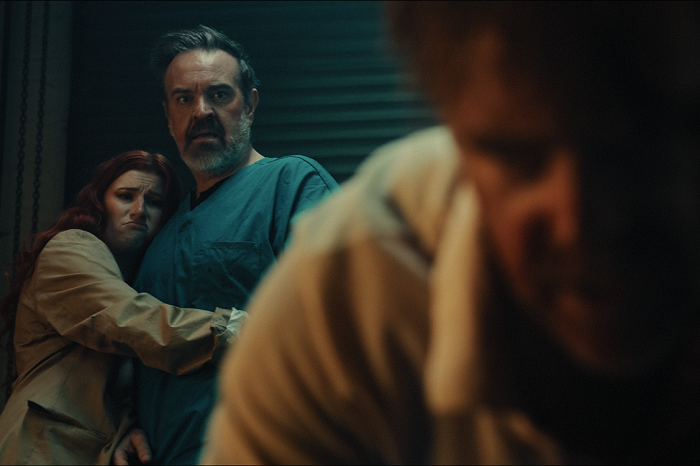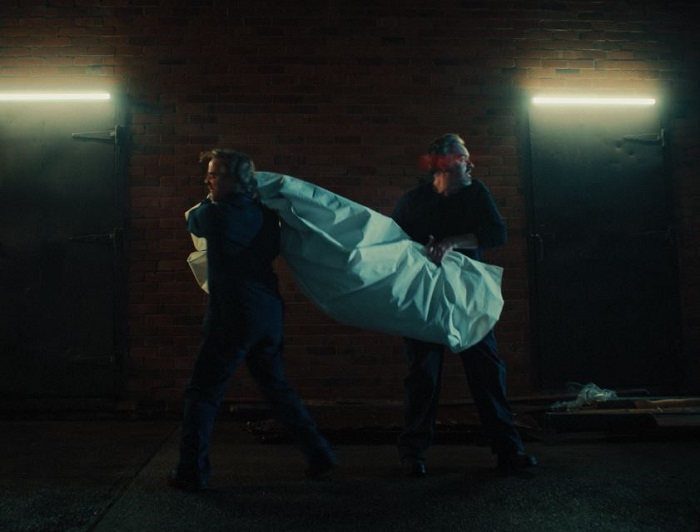by Erin Free
Co-director, writer and star Craig Armstrong and co-director Shelly Higgs work a little dark magic with their highly original Aussie black comedy Snatchers, which was shot in the decidedly un-Hollywood environs of the nation’s capital of Canberra.
“Snatchers is about refusing to play it safe,” says co-writer and co-director Shelly Higgs. “At first glance, it’s a dark comedy about two men trying to sell a corpse’s organs, but beneath the absurdity lies a story about class divide and exploitation. Those themes are close to my heart, and wrapping them in irreverence and humour made them accessible without losing their bite.”
In a broken-down, dilapidated hospital in a strange, dystopian Australia, best mates Mac (Craig Alexander) and Fettes (Justin Hosking) scrape by as grimly underpaid and horribly under-appreciated orderlies. Desperate for cash, they steal what looks like the perfect black-market score: a young, healthy corpse known only as Jane Doe (Hannah McKenzie). But just as the boys prepare to harvest her organs, Jane wakes up on the operating table.
What follows is a darkly comic spiral of greed, fear, and survival, as Mac and Fettes struggle to manage a not-so-dead body, outwit the authorities, and wrestle with their own desperation while their moral compasses spin out of control.
Melding horror with razor-sharp satire, Snatchers has much to say about the state of the world, all bundled together with a wickedly absurd sense of humour.

Where did this very unusual concept for a feature come from?
Craig: “Having always been a horror fan, and particularly interested in classic horror tales, I came across Robert Louis Stevenson’s The Body Snatcher whilst looking for my next project and realised it would be a great story to play around with. A contemporary, Black Mirror-esque adaptation for the stage was my initial impulse, but I quickly realised I could have a lot more fun making it for screen.”
There’s always a lot of interest about how co-directors work… what is your process?
Shelly: “For this film, one of the greatest reasons for having a co-director was practical. As Craig wrote and starred in the film, we decided to have me on set, so I could make all of the calls on the day, without Craig having to review everything on screen afterwards and slow down production. We just didn’t have the time. My background is theatre directing, so I naturally focus on relationships and character and story beats which was a very useful balance to Craig’s work as a director, which was more of the visioning – the look, style, tone etc. I guess we balanced each other out. I worked really closely with Craig on the script, as story editor, so I knew the work inside out and what it is that he wanted to achieve. But it was really important to let the overall vision stay with Craig, as he conceived the whole thing from start to finish. The edit was in his head. Making that decision – that the final say rested with one person – really helped delineate the work. It also takes massive amounts of trust. Craig trusted that I would work to his vision, and that when I pushed back, it was for good reason. He accepted my say that what we just shot was good enough to move on.”

Canberra is not really hailed as a great filmmaking centre. What was it like shooting there? And why did you choose it?
Shelly: “We have made our home and career in Canberra, so it was important for us to champion the work of local creators and prove that Canberra can hit above its weight when it comes to creative output. The Arts Minister has great plans for Canberra to be hailed as the Arts Capital of Australia… but how can that happen unless you invest in the artists and creators making work? So that was probably our rather idealistic viewpoint. Having gone through it, however, it’s clear there isn’t quite the support or infrastructure available to filmmakers here – yet … so we possibly shot ourselves in the foot trying to stay so local. Having to source various crew, cast and equipment from interstate definitely added costs and logistical issues; and with little incentive available, it stretched our meagre budget beyond our initial plans. That said, the local community really got behind us and we were so lucky to be supported so well by Narrabundah College. They loaned us their school during the holidays to turn into a dilapidated hospital, and a local event venue allowed us to turn their building into an abandoned warehouse. Even the Canberra Outlet Centre gave us night access to use their goods lift and carpark. Not to mention all the family and friends that chipped in where they can – they’re the backbone of indie film everywhere.”
One of the highlights of the film is its impromptu dance sequence! Can you talk about the thinking behind that? And also some of the process in making it happen and getting it all together?
Craig: “From the beginning, I wanted to play around with how we tell stories, not only on stage or screen, but the stories we tell to each other. Sometimes they’re heightened, details are changed, facts are ignored, perspectives shift – all to make our point. The dance sequence came out of that idea. We had some fun with it, working with local dance studio Project Beats and some enthusiastic extras to bring it to life.”

Craig, you are a real multi-tasker on this project. How did you find wearing so many hats? Any focus issues?
Craig: “Too many hats, to be honest! Ideally, I wouldn’t have had to but that’s indie filmmaking for you. Having Shell and the team around made it much easier, but I would push to not do that again! Post-production was probably the most frustrating… fellow directors warned me that I might hate the film by the end of post, and they weren’t wrong…”
Can you talk a little about the casting process? Justin Hosking is a bit of a scene-stealer here…
Shelly: “Being an indie feature, casting fell to us, but we have been on both sides of the casting process. I’ve cast many theatre shows and Craig has been through many an audition. We went through Showcast and created a shortlist and were looking for specific characteristics that were core to the characters and then hit up agents for tapes. We did go out to a few names, but couldn’t offer enough to woo them to our cause. Luckily, Craig had met Justin previously through some workshops, and as soon as we saw a random self-tape he had done, we knew we had found our Fettes. Jane Doe was a little trickier; there were so many great tapes from talented people but none quite captured the character. With Hannah, we were so fortunate that Craig had seen her work earlier through a short film, so we reached out for a self-tape and it was evident, almost immediately, that she could bring the nuance and spark the role needed. We then had call backs via Zoom and the dynamic between the three main actors cemented it. For the smaller roles, it was important for us to cast local actors who are committed to the industry, so we went out to our networks to find the right people.”

What was the greatest challenge during the creation of the film?
Craig: “The biggest challenge for any filmmaker is not having enough money or time. All the challenges stem from that. You’re asking a lot of your team and trying to achieve your vision but it seems like around every corner there’s another roadblock. You just need to be flexible and adapt as required, but a lot of creativity can come out of those restraints. It makes you think really hard about story. What is the minimum we can do to get the story beat we need?”
Shelly: “The most surprising challenge is learning that shooting the feature is the easy bit! It’s the post-production and getting the word out that takes a marathon effort. There isn’t a magic moment, it’s not like you get a film in the can and it’s all done. There’s still so much work to do to get it in front of audiences.”
What was the biggest surprise during the creation of the film?
Craig: “How much fun shooting a feature can be… at least this one! Yes, it is exhausting, and yes, it’s stressful, but when you have a great team around, it becomes a joy to show up – exhausted – every day. Can’t wait to get into the next one.”

The general conception is that it’s very tough out there for Australian creators in the local film industry. Has that been your experience?
Craig: “Yep. As a first-time feature maker, there’s a lot of pushing up hill to get a foot in the door. Right from the financing stage through to getting it in front of audiences, it’s a tough gig and not for the faint of heart. Worthwhile yes, but if you’re at the beginning of a similar journey, just remember to back yourself and keep pushing forward. I’d also recommend finding a mentor for a bit of guidance. I was lucky enough that Mark Grentell (Backyard Ashes, The Merger) was willing to offer advice throughout the process. Having someone that’s been in the trenches to bounce ideas off was invaluable.”
What do you have planned for the release of the film, and do you have any new projects in the pipeline?
Craig: “We’ve been lucky enough to have some great festival screenings around the world so far (Raindance London, Sydney Underground and Capital Film Fest), so now we’re working with Screen Inc. to get it in to a few cinemas to give people an opportunity to catch it on the big screen and then onto digital so people can catch it at home. As for new projects, we’ve got a couple in development including a limited series that’s kind of Succession-for-normal-people and a horror feature that subverts the Hallmark Christmas formula.”
Snatchers screens at the Lido Cinemas in Melbourne on 16 November 2025, tix here. It then screens in-season at the Limelight Cinema in Tuggeranong in Canberra from 11 December 2025.




